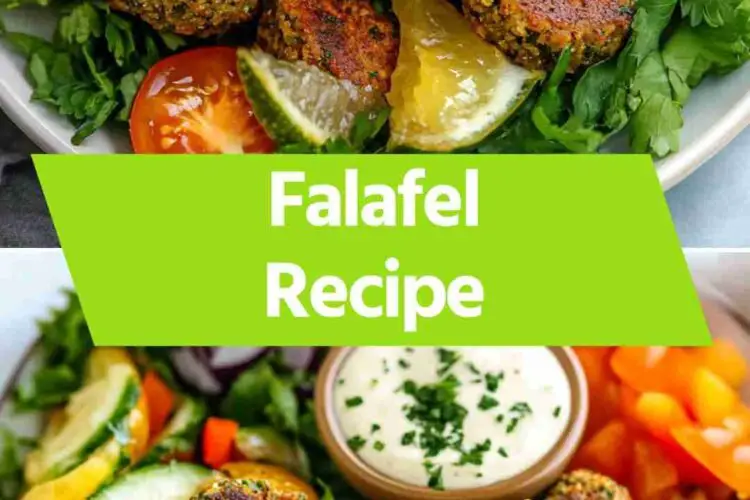Before diving into the wonders of falafel, let’s chat about what pairs well with this mouthwatering dish. A fresh, crisp salad is a fantastic complement. Think cucumber and tomato salad drizzled with lemon juice and olive oil.
Hummus, of course, is a classic match; its creaminess offsets the crunch of falafel beautifully. For a more filling option, toss together a simple tabbouleh made with parsley, tomatoes, bulgur, and a splash of citrus.
If you enjoy a bit of zing, serve your falafel in a warm pita with tzatziki sauce and pickled vegetables for an explosion of flavors. And don’t overlook the power of a side of fries. Yes, you heard that right! Crispy fries make for an unexpectedly delightful pairing that many enjoy.
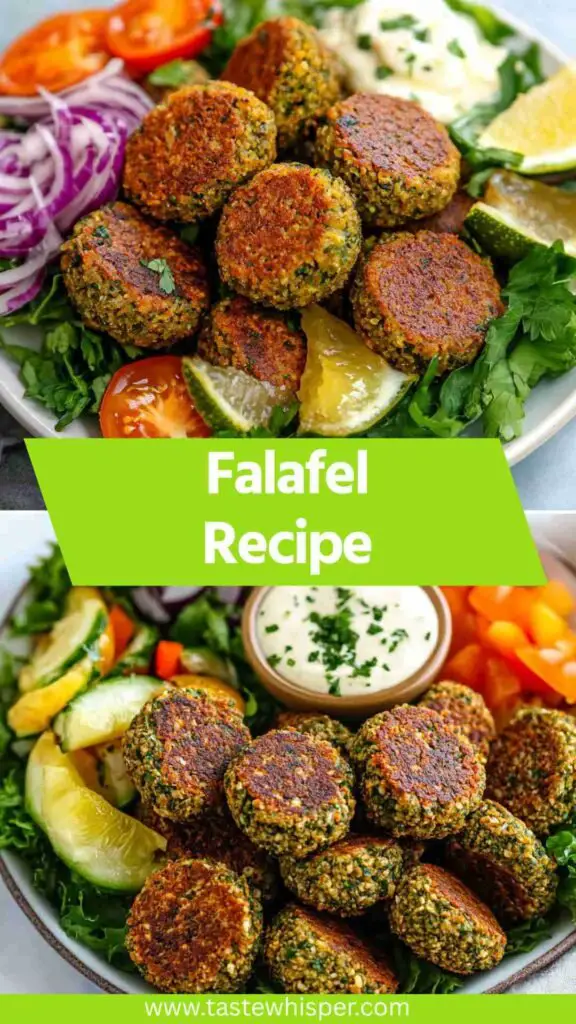
Today, we’re diving deep into a dish that has won hearts around the globe—falafel. You’ll often find it as a popular street food in the Middle East, but it’s gaining massive traction everywhere.
Trust me; once you try making it from scratch, you’ll be hooked. It’s crunchy on the outside, soft on the inside, and bursting with flavor. Plus, it’s a wonderful plant-based option that’s packed with protein.
But there’s more to falafel than just throwing some chickpeas and spices together. It takes a blend of art and science to get that perfect texture and taste. Buckle up as we navigate through everything you need to know about falafel, from ingredients to storage tips.
What is Falafel?
Falafel is a deep-fried ball or patty made from ground chickpeas or fava beans, or a combination of both. Originating in the Middle East, it’s a staple in many countries, each offering its own unique spin on this delicious treat.
While street vendors in Jerusalem may serve it wrapped in pita with fresh veggies, Egyptians have a unique spin using fava beans and spices. Falafel’s flexibility makes it a versatile meal option enjoyed by many.
What is the Flavor Profile of This Dish?
The flavor profile of falafel is truly a dance of spices. When made right, one bite reveals a multitude of tastes. You encounter the earthiness of chickpeas, complemented by a mix of fresh herbs like parsley and cilantro.
Cumin provides a warm background note, while garlic adds a bit of a kick. The spices and herbs work together, creating a savory experience that feels both homey and energizing. There’s a hint of nuttiness from tahini, and a subtle heat from cayenne pepper, making every bite intriguing and satisfying.
What Makes This Recipe Different from Other Falafel?
What sets my falafel recipe apart is the freshness of the ingredients and the careful balance of spices. Instead of relying on dried herbs, we’re using vibrant, fresh herbs to infuse the mix with flavor.
The combination of lemon zest and tahini brings a unique brightness that many recipes might overlook. I believe the secret lies in the freshness—you want each ingredient to shine and support the others, rather than drown them out.
You’ll Also Like The Following Recipe
Ingredients You’ll Need
To whip up this delightful treat, gather the following ingredients:
- 8 ounces dried chickpeas: Dried is preferable; canned won’t achieve the same texture.
- 5 to 6 stalks of green onions, trimmed: Adds a subtle onion flavor without being overpowering.
- 4 medium cloves of garlic: You can never go wrong with garlic.
- 2 cups tightly packed fresh herbs: A combination of parsley and cilantro is ideal.
- 1 tablespoon lemon zest: For that burst of citrus.
- 1 tablespoon tahini: This gives a creamy texture.
- 1 teaspoon fine sea salt: Essential for flavor.
- 1 teaspoon ground cumin: Adds warmth.
- 1/2 teaspoon ground coriander: A citrusy, floral note.
- 1/2 teaspoon ground cardamom: For an intriguing hint of sweetness.
- 1/8 teaspoon cayenne pepper: Just the right amount of heat.
- 1/4 teaspoon freshly cracked black pepper: A necessary staple.
- 3/4 teaspoon baking powder: Helps lighten the mix.
- Vegetable oil: For frying, choose a high smoke point oil like canola or sunflower.
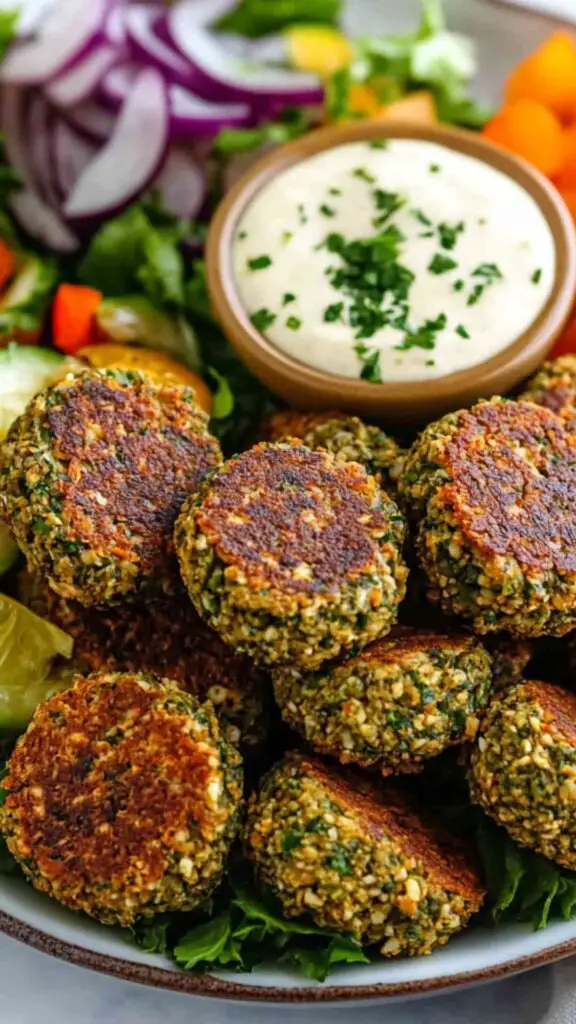
Step by Step Directions
Step 1: Soak the Chickpeas
Start by soaking the dried chickpeas overnight in ample water. This is crucial, as it will rehydrate them and make them easier to process. Ensure they are covered with a few inches of water, because they will expand.
Step 2: Prepare the Herb Mixture
Once the chickpeas are ready, drain them and set aside. In your food processor, combine the chickpeas, green onions, garlic, and fresh herbs. Pulse until everything is finely chopped but not pureed. You’re aiming for a coarse texture.
Step 3: Mix the Spices
Transfer the chopped mixture to a large bowl. Add in the lemon zest, tahini, salt, cumin, coriander, cardamom, cayenne, black pepper, and baking powder. Mix everything together until well combined.
Step 4: Chill the Mixture
Cover the bowl and place it in the fridge for 30 minutes. This resting period is key. It allows the flavors to meld and firms up the mixture, which will help with shaping later on.
Step 5: Shape the Falafel
Once chilled, wet your hands slightly, and grab a small amount of the mixture. Shape it into balls or patties, whatever your preference. Keep them about the size of a golf ball for best results.
Step 6: Heat the Oil
In a deep-frying pan, heat vegetable oil over medium heat. You want enough oil to cover the falafel as they fry, typically around 2-3 inches deep. To check if the oil is hot enough, drop in a small piece of the mixture; if it sizzles right away, you’re good to go.
Step 7: Fry the Falafel
Carefully drop the shaped falafel into the hot oil. Fry them in batches, making sure not to overcrowd the pan. Cook for about 3-4 minutes on each side until they are golden brown and crispy.
Step 8: Drain and Serve
Once cooked, transfer the falafel to a plate lined with paper towels to drain any excess oil. Serve immediately with your choice of sides and sauces.
Tips on Making Falafel
- Use Dried Chickpeas: Canned chickpeas can lead to a mushy texture. The dried ones are essential for the right bite.
- Be Generous with Herbs: Fresh herbs add a brightness that frozen or dried ones just can’t replicate.
- Avoid Over-Processing: Pulse the mixture until finely chopped, but avoid making it a paste.
- Fry in Small Batches: Crowding the pan lowers the oil temperature and results in soggy falafel. Give them space.
- Let Them Rest: Chilling the mixture helps firm it up, making shaping easier.
Nutrition Information
Falafel nutrition facts
How Can I Store This Falafel?
To store leftover falafel, allow them to cool completely. Place them in an airtight container and refrigerate for up to three days. For longer storage, consider freezing them. Arrange the cooled falafel in a single layer on a baking sheet and freeze until solid. Then transfer them into a freezer-safe bag. They’ll last for about two months. Reheat in an oven or air fryer for best results.
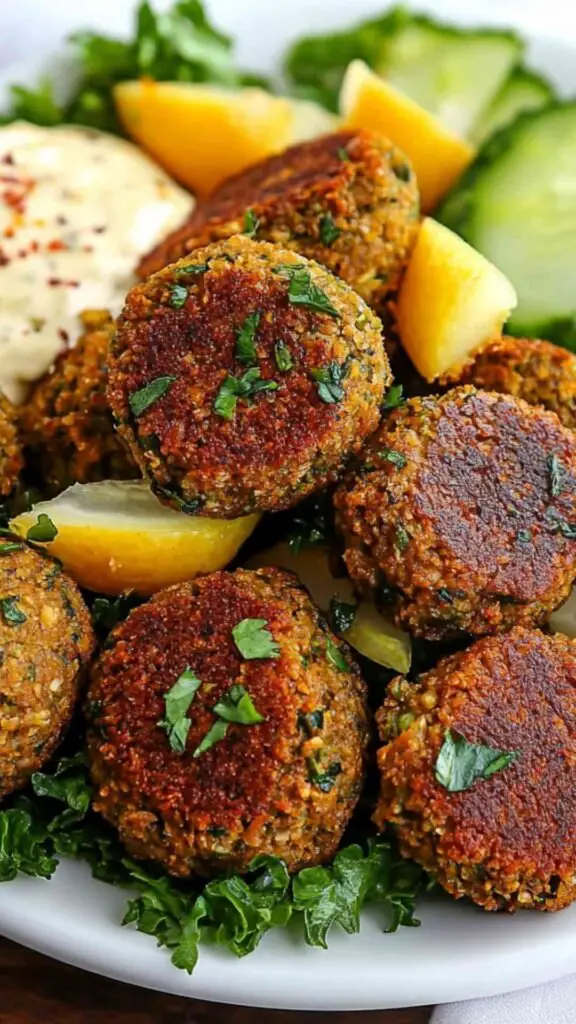
Substitute Options for Ingredients
Sometimes, you might not have every ingredient on hand. Here are some substitutes that can work:
- Leeks for Green Onions: If you’re out of green onions, finely chopped leeks can provide a milder, sweeter flavor profile.
- Olive Oil for Vegetable Oil: Any high smoke point oil will work, so olive oil is a perfectly good choice, adding its unique flair.
- Chickpea Flour for Chickpeas: In a pinch, you could use chickpea flour mixed with water, but it will change the traditional texture.
- Sunflower Butter for Tahini: In case tahini is nowhere to be found, sunflower butter adds a similar creaminess while keeping it nut-free.
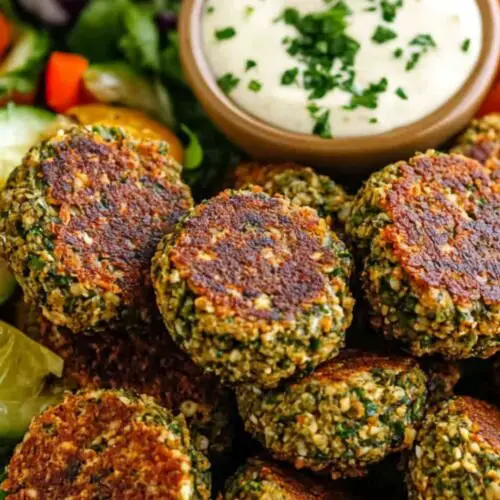
Falafel
Equipment
- Large bowl
- Frying Pan
Ingredients
- 1 tablespoon lemon zest
- 1 tablespoon tahini
- 8 ounces dried chickpeas
- 5 to 6 stalks of green onions trimmed
- 4 medium cloves of garlic
- 2 cups tightly packed fresh herbs
- 1 teaspoon fine sea salt
- 1 teaspoon ground cumin
- 1/2 teaspoon ground coriander
- 1/2 teaspoon ground cardamom
- 1/8 teaspoon cayenne pepper
- 1/4 teaspoon freshly cracked black pepper
- 3/4 teaspoon baking powder
- Vegetable oil
Instructions
Step 1: Soak the Chickpeas
- Start by soaking the dried chickpeas overnight in ample water. This is crucial, as it will rehydrate them and make them easier to process. Ensure they are covered with a few inches of water, because they will expand.
Step 2: Prepare the Herb Mixture
- Once the chickpeas are ready, drain them and set aside. In your food processor, combine the chickpeas, green onions, garlic, and fresh herbs. Pulse until everything is finely chopped but not pureed. You’re aiming for a coarse texture.
Step 3: Mix the Spices
- Transfer the chopped mixture to a large bowl. Add in the lemon zest, tahini, salt, cumin, coriander, cardamom, cayenne, black pepper, and baking powder. Mix everything together until well combined.
Step 4: Chill the Mixture
- Cover the bowl and place it in the fridge for 30 minutes. This resting period is key. It allows the flavors to meld and firms up the mixture, which will help with shaping later on.
Step 5: Shape the Falafel
- Once chilled, wet your hands slightly, and grab a small amount of the mixture. Shape it into balls or patties, whatever your preference. Keep them about the size of a golf ball for best results.
Step 6: Heat the Oil
- In a deep-frying pan, heat vegetable oil over medium heat. You want enough oil to cover the falafel as they fry, typically around 2-3 inches deep. To check if the oil is hot enough, drop in a small piece of the mixture; if it sizzles right away, you’re good to go.
Step 7: Fry the Falafel
- Carefully drop the shaped falafel into the hot oil. Fry them in batches, making sure not to overcrowd the pan. Cook for about 3-4 minutes on each side until they are golden brown and crispy.
Step 8: Drain and Serve
- Once cooked, transfer the falafel to a plate lined with paper towels to drain any excess oil. Serve immediately with your choice of sides and sauces.
Video
Notes
- Use Dried Chickpeas: Canned chickpeas can lead to a mushy texture. The dried ones are essential for the right bite.
- Be Generous with Herbs: Fresh herbs add a brightness that frozen or dried ones just can’t replicate.
- Avoid Over-Processing: Pulse the mixture until finely chopped, but avoid making it a paste.
- Fry in Small Batches: Crowding the pan lowers the oil temperature and results in soggy falafel. Give them space.
- Let Them Rest: Chilling the mixture helps firm it up, making shaping easier.
Nutrition
Frequently Asked Questions
1. Can I bake falafel instead of frying?
Absolutely! Baking is a healthier option. Preheat your oven to 400°F (200°C). Brush the formed falafel with oil and bake for 25-30 minutes, flipping halfway through until they’re golden.
2. Is falafel gluten-free?
Yes, falafel made with chickpeas is naturally gluten-free. Just make sure to check any additional ingredients for gluten.
3. Can I make falafel in advance?
Definitely! You can prepare the falafel mix ahead of time and refrigerate it. Shape and fry them just before serving for the best texture.
4. What’s the best way to reheat falafel?
Using an oven or air fryer is best for reheating, as it restores the crispiness. Microwave tends to make falafel soggy.
5. Are there vegan options for sauces that pair with falafel?
Certainly! Hummus is a popular choice, as are tahini-based sauces mixed with lemon and garlic. A simple yogurt alternative made from cashews or soy can also work beautifully.
1. Can I bake falafel instead of frying?
Absolutely! Baking is a healthier option. Preheat your oven to 400°F (200°C). Brush the formed falafel with oil and bake for 25-30 minutes, flipping halfway through until they’re golden.
2. Is falafel gluten-free?
Yes, falafel made with chickpeas is naturally gluten-free. Just make sure to check any additional ingredients for gluten.
3. Can I make falafel in advance?
Definitely! You can prepare the falafel mix ahead of time and refrigerate it. Shape and fry them just before serving for the best texture.
4. What’s the best way to reheat falafel?
Using an oven or air fryer is best for reheating, as it restores the crispiness. Microwave tends to make falafel soggy.
5. Are there vegan options for sauces that pair with falafel?
Certainly! Hummus is a popular choice, as are tahini-based sauces mixed with lemon and garlic. A simple yogurt alternative made from cashews or soy can also work beautifully.
Conclusion
Falafel is more than just food; it’s a celebration of flavors, culture, and creativity. Once you master the art of making falafel, you’ll uncover endless possibilities for variations and pairings.
Whether you enjoy it on a fresh salad, inside a sandwich, or with fresh dips, falafel is bound to be a hit. I hope you embrace this fantastic culinary journey, experimenting until you find your perfect combination.
Falafel made at home is not just enjoyable; it creates memories around the dinner table. Get ready to share delicious moments with friends and family!

